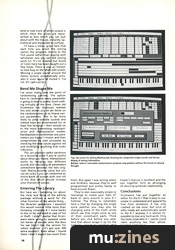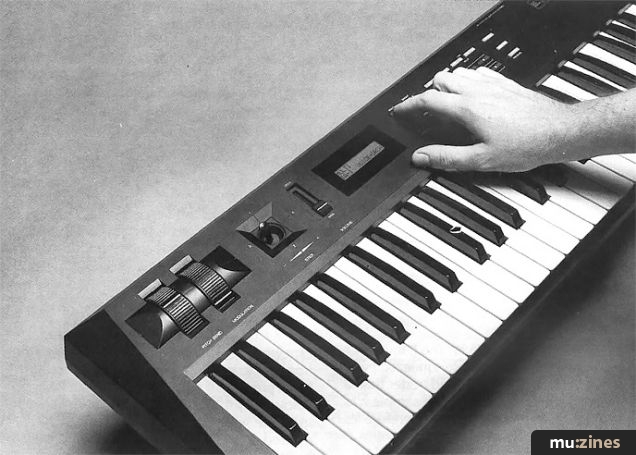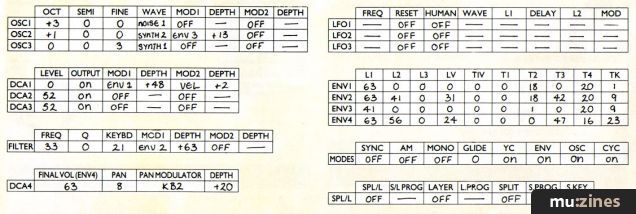Magazine Archive
Home -> Magazines -> Issues -> Articles in this issue -> View
Harness the Waves | |
Article from Micro Music, August/September 1989 | |
Colin Cat takes the K-1r to greater heights with Drumware's Editor/Librarian package
How could you possibly make a K1 any better? By adding an editor/librarian package like the one from Drumware - as Colin Cat discovers

On the day that Kawai released the K-1 keyboard, one might imagine the research teams from Yamaha and Casio heading down the local sushi bar to drown their sorrows in sake. A remarkable touch-sensitive multi-zoned keyboard with a sound generation system that zings like the strings of your heart, and tagged at a merciless price of £599.
Kawai has recently followed through with the rack-mounting K-1r and the tabletop K-1m, plus the new improved K-1 II (with extra added zing). While this is hardly likely to deal a death blow to the DX range, it has certainly been enough to establish Kawai firmly into the pro synth market as well as gaining respect and many second looks at its more traditional organ trade.
Personally I have always found my K-1 pretty easy to program. I was reared on DX-style algorithm manipulation and the four sources of each single sound on the K-1 are handled in a pretty similar fashion. The mammoth advantage of the K-1 design system is the positive plethora of possible waveforms you can take as your starting point. So my immediate thought on being offered Drumware's K-1 editor/librarian package was that it simply wasn't necessary, that it couldn't improve on the original.
Well brothers and sisters I was wrong. Drumware's package has converted me with heart a-flutter to the art of on-screen editing and now I wouldn't dream of leaving home without it. "Coo" say I, and the audience says "coo" along with me. Let me tell you why.

The Main Editing Screen for K1 single sounds
Running the Program
The K-1 Ed-Lib package is protected by a dongle, but very sensibly Drumware has opted for a small dongle that sits in the spare joystick port. This means that you don't have to chop and change your dongles as you move from sequencer to editor, which is just as well as it takes several minutes and a broken nail to get the little sucker out from that oh-so-tight and inaccessible joystick port under the ST. You can leave the dongles and concentrate on slipping your discs. After checking that your K-1 is connected via MIDI in both directions ready for a chat, the program launches straight into the editing screen for a single patch.
It's not much fun editing nothing (well it is but it takes so long) so the first thing to do is upload all the sounds from the K-1 into the program. This takes all of five seconds and gives you 64 single sounds and 32 multi-patches all wound up and ready to play.
There is a stumpy five octave keyboard at the foot of the screen. Clicking the mouse on any key plays the patch on which you are working. There are options to play a chord instead of a single note, or to sound the note automatically every time you alter anything. The on-screen keyboard can give velocity information (the closer to the top of the note the louder it is), aftertouch (holding the mouse button and wobbling it) and modulation (holding everything in sight and wobbling it).
Obviously zooming around the screen with a mouse will not enable you to play much faster than you could achieve on a real keyboard using your nose. Ideally you should be able to trigger notes from an external master keyboard which is not possible if you are working on the keyboardless K-1r or K-1m. Confusingly Drumware has added a read-this-first file to the latest version (1.2) saying that the addition of a software MIDI THRU makes this possible but unless my legendary powers of deductive wiring fail me... er I think you'll find it doesn't. Not without a THRU box anyway. But no matter. Let us turn to the editing itself.
Half the single voices are listed on-screen and you can toggle to view the other half either by selecting from a pulldown menu or by a keyboard command. Choosing a voice is performed by clicking on a title from this list. Immediately all the parameters of that sound are indicated. It is then childs play to wreak havoc with a well engineered sound by altering everything in sight. The danger here is that the alterations are sent to the K-1 as you make them, overwriting the original parameters and wiping that wonderful patch that Mr Kawai and his happy family spent months programming. But fear not! We are saved by that messiah of the keyboard - the Undo key which pulls the original back from a software buffer. Sighs of relief and a cup of Horlicks all round. The only catch is that you must not select another patch before you undo the one you've ruined (you could actually instigate a secondary buffer but might get confused in the process).
Changing patches in midstream wipes the buffer and leaves you crying into the Horlicks. For this reason it is ever so vitally important that the first thing you do when you load the K-1 Ed-Lib is to upload and SAVE everything you own, as insurance against the rainy day when the cat leaps onto your keyboard at just the wrong moment.

Click and drag envelope editing
Inside The Envelope
As I have said, the basics of K-1 programming are easily grasped. Once you get to the fine tuning things get a little more hairy (keyboard scaling, velocity scaling, kitchen scaling and so on) but having everything available on one screen is a great help. More importantly it is an incentive to play and find out what some of the lesser used parameters actually do, rather than pretending you don't need them as I suspect many people do (this means me of course). Perhaps the most time-saving operation is the editing of envelopes. There are four of these, one for each source wave. Normally they are displayed graphically, each in a box about 3cm by 1cm.
However clicking on one of these boxes brings the envelope to the larger lower window where you can pull the ASDR levels around with your mouse. Numerical values for the envelope are displayed in this larger window. Especially useful is the envelope tracking function. Enabling this will pull all four envelopes about in synchronisation with whichever you put in the larger window, so that the sound can be altered without creating any sharp edges. Anyone who has sat for hours with a DX synth copying numerical ASDR figures from one operator to another will appreciate the time being saved here.
The other brimming pot of convenience available on the single patch edit screen is immediate access to the full list of primary waveforms available for each source. Although Kawai supply a handy checksheet it is much appreciated to select them by name rather than number and to have them permanently on display.

The screen for editing Multisounds showing the component single sounds and the bar display of zoning information.
Multi-Patch Editing
This is where things really get moving. Multi-patches consist of up to eight single patches combined in just about any way you can conceive. When you move to the Multi-Edit screen and load a multi-patch, the eight singles are listed in a table with all the levels, balances and tunings instantly clickable. And the zoning is a joy to use.
Zoning is when you allocate a sound to a particular area of the keyboard so that you could have say strings and harpsichord down at the bottom of the keyboard with perhaps a mongoose cry in the top octaves. The eight sounds are individually zoned and can overlap if desired - enormous versatility that really sets the K-1 apart from other keyboards. Programming direct onto the K-1 manually, each zone is entered as low note and high note identified as A-G plus octave number. The method is fallible as you tend to lose track of which octave is which. Here the zones are represented as bars which you can pull about with the mouse, instantly operational and impossible to confuse.
I'll have a minor gripe here that each time you select the zoning option the program reverts to the first sound rather than staying with whichever one you last did zoning work on. It's no disaster but dumb ol' Colin here has been caught out a few times. There is also an honest-to-God bug on the Multi-edit screen. Moving a single sound around the stereo picture automatically activates it, even if you've muted it. Tut tut. Do I get a prize?

Total or controlled randomisation produces new patches without the hassle of rational thought
Bend Me Shape Me
I've never really seen the point of randomising patches. The option here to randomise every parameter is going to lead to pretty much nothing virtually all the time. Clever old Drumware has obviously realised this and allows you to set limits on the randomisation or to freeze various parameters. This is far more likely to yield sensible sounds and indeed kept me entertained for at least five minutes. I then moved on to the more interesting randopolation and interpolation modes. Randopolation randomises any parameters you haven't frozen and then compromises its own processes by checking the new values against old and modifying anything that looks ridiculous.
This can produce useful variations on a favourite voice if you're careful about what you freeze. Interpolation works by merging two different sounds and relocating all parameters somewhere between the two originals. Mainly novelty value but you can be lucky - you can randomise an entire bank of sounds with one roll of the dice which should increase your chances of success.
Entering The Library
But here am I rabbiting on about the clicks and tricks of the editing package without a word for the other function of the whole thing - the librarian operations. I assumed this would involve little more than dumping complete K-1 voice banks to disc to be retrieved in case of fire or theft. I didn't realise that Drumware were going to squeeze some ten banks of sounds onto the discs for me (don't bin the version for colour monitor - it's got over 300 extra sounds!). Even when I found them I didn't expect too much from them. But again I was wrong sisters and brothers, because they're well programmed and pretty handy to have around. Bravo.
They're also reasonably simple to rearrange to create your 'best of' bank to carry around in your K-1 fulltime. The thing to remember here is that by changing the single voice patches you may also be changing some of the multi voices which use that single voice as one of their constituent parts. Think before you click before you save. And that about wraps it up for the package, except to mention that the manual is fairly brief and expects you to understand individual parameters before you start. Happily Kawai's manual is excellent and the pair together form an all-singing all-dancing symbiotic relationship.
Conclusions
Drumware has put together an editor for the K-1 that is easy to use, simple to understand and apparently free from omissions. It has only crashed on me once, but since all edits made are automatically saved to the K-1 anyway it is almost impossible to lose any hard work. Only the most miserable K-1 owner could claim anything less than wholehearted satisfaction.
Product: K-1 Editor/Librarian
Format: Atari ST
Supplier: Hybrid Arts UK Ltd, (Contact Details)
Also featuring gear in this article
Browse category: Software: Editor/Librarian > Drumware
Featuring related gear
Kawai K1
(MT Jun 88)
Kawai K1 Synthesizer
(SOS Jun 88)
Kawai K1/K1M
(MT Mar 88)
Making The Most Of Your Kawai K1
(SOS Feb 90)
Patchwork
(MT Jan 89)
Browse category: Synthesizer > Kawai
Publisher: Micro Music - Argus Specialist Publications
The current copyright owner/s of this content may differ from the originally published copyright notice.
More details on copyright ownership...
Review by Colin Cat
Help Support The Things You Love
mu:zines is the result of thousands of hours of effort, and will require many thousands more going forward to reach our goals of getting all this content online.
If you value this resource, you can support this project - it really helps!
Donations for April 2024
Issues donated this month: 0
New issues that have been donated or scanned for us this month.
Funds donated this month: £7.00
All donations and support are gratefully appreciated - thank you.
Magazines Needed - Can You Help?
Do you have any of these magazine issues?
If so, and you can donate, lend or scan them to help complete our archive, please get in touch via the Contribute page - thanks!












